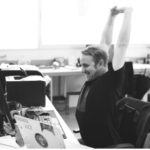When humans spent their time hunting and gathering, there were several events that could shorten our lives such as disease, parasites, and predators. However, obesity and inactivity were not that much of a concern. Simply surviving expended a lot of energy and calories. Now that we have the luxury to spend our days in a cubicle or in front of the television, we face a new threat. How does sitting negatively impact our health long term?
1. Spinal Health Impact
The more time you spend sitting, the weaker your core muscles get. As your abdominal and low back muscles lose flexibility and strength, you may start to have low back issues, which can further limit your mobility. In addition, sitting all day can cause tight hip flexors and may even lead to swelling in our feet. This can make it difficult to get excited about getting up and moving around. In addition, many of us need to sit to do our jobs and may enjoy some leisure activities that are easier from a comfortable chair.
So how do we keep moving? Experts recommend standing whenever possible at the office, taking the stairs when you can, park a long way from your goal and sticking to an exercise program. If you can get access to a standing desk, use one. Shift from foot to foot or stand on one foot to build core strength. Treadmill desks and portable pedal mechanisms can also help to keep your blood flowing and your body strong.
 You can further protect your spine with a focus on proper posture, including
You can further protect your spine with a focus on proper posture, including
- keeping your shoulders back
- pulling in your abs
- keeping your feet shoulder-width apart
2. Circulation Issues
Your heart has to work harder to move blood effectively through your body when you’re all folded up. In addition, sitting for long periods of time can actually impact your mood and your spirit, which can affect your blood pressure. One of the great powers of exercise is that it boosts your mood and gets you excited for the next step in your day.
If you simply can’t get away from your workspace during your day, try to find a private spot for some simple yoga. This practice gets you away from screens, clears your mind and lifts your mood. There are many simple poses or moves you can do on your own. Just shut the door, slip off your shoes and jacket, and move your body. If you don’t have a mat, remember to lunge with care as your bare feet may slide on the flooring.
3. Cardiac Health Challenges
Can you overcome the risks of excess sitting with an exercise program? Not exactly. While an exercise program can help prevent the cardiovascular risks of spending most of your day in a chair, your exercise program can’t completely mitigate the risk. Our bodies evolved to be upright, not folded into a chair. This inactivity puts many systems of your body at risk for poor functioning and failure.
We all schedule our days. There may be meetings, phone calls and webinars to attend. You may have deadlines you have to meet. To make getting out of your chair a priority, put it on your calendar or add it to your task list. Set up “walk around the floor” or “climb a flight of stairs” on your task list and have the popups scheduled to come up 16 times a day. That means that twice an hour, you have to get up to do something. Then check off what you accomplished. During intense times you may need to turn these reminders off. However, this is a great way to get your body up and going, and it may help you connect with co-workers on things you needed to discuss anyway. Best of all, you can be encouraging them to move.
4. Weight Gain
Sitting too much makes it easier for your body to turn your food into fat. For some people, excess sitting can lead to high blood sugar and may contribute to type 2 diabetes. If possible, spend your time after lunch standing. You might file somewhere in your office, stock up a cabinet, take part in a conference call or take a class on-line. In any of these circumstances, you can be on your feet.
Shoot for at least 180 minutes of standing or moving after your meal to lower your blood sugar and let gravity help you digest your lunch. If this simply won’t be acceptable in your workplace, try to walk or at least be on your feet for at least 2 minutes after 20 minutes of sitting after a meal.
When you think about it, poor health outcomes from sitting too long is actually quite a luxury. Those of us lucky enough to have been born in the developed world actually have to fight to burn off enough calories to stay healthy. For a strong body as we age, we have to make it possible to get away from our chairs.
 Article contributed by Dr. Pete Hinz, Chiropractor, Cool Springs, Franklin, Tennessee, USA
Article contributed by Dr. Pete Hinz, Chiropractor, Cool Springs, Franklin, Tennessee, USA




